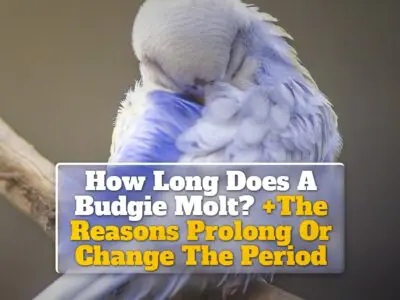Budgies typically molt once or twice a year, often coinciding with changes in season.
Molting can occur in all seasons – spring, summer, winter, and autumn, though it’s most common in spring and fall due to shifts in daylight hours. Changes in temperature are also among the factors.
It’s common to notice them losing their feathers at certain times, but when exactly do budgies molt? And is it something that happens throughout the year, or are there specific times when they molt?
My observations from owning a budgie suggest that molting in budgies is a complex process influenced by multiple factors.
The seasons, their age, and even their diet can play a role in when and how often they molt.
When How Often Budgies Molt?
The molting process in budgies is a natural phenomenon wherein they shed their old feathers to make way for new ones.
Molting in budgies typically happens once or twice a year, but the timing can depend on various factors, including the bird’s age, diet, and the environmental conditions.
When Do Budgies Molt In Their Habitat?
When we talk about a budgie’s natural habitat, we’re referring to the arid regions of Australia.
In this environment, budgies generally molt in response to the rainy seasons when food becomes abundant.
This period typically falls during late summer to early autumn, although this can vary depending on the specific climate patterns of the year.
This molting cycle is attuned to the budgie’s survival needs, aligning with the times when they have enough resources to support the energy-intensive molting process.
When Do Captive Budgies Molt?
For captive budgies, the molting pattern can be quite different.
These birds are not subjected to the environmental changes of the seasons like their wild counterparts.
Instead, they experience a more controlled environment that doesn’t necessarily mimic the natural fluctuations of the Australian landscape.
Typically, captive budgies might molt twice a year, but there’s a catch.
Since they are often exposed to consistent light and temperature conditions, their molting can happen at almost any time of the year.
This situation may sound less stressful, but it’s vital to remember that abrupt changes in their environment (like sudden temperature drops or changes in light exposure) can disrupt their molting cycle, potentially causing stress.
Do Budgies Molt In All Seasons?
Whether budgies molt in all seasons depends on a myriad of factors, including their natural habitat or the conditions they live in.
For budgies in their natural habitat, molting often coincides with periods of abundant food supply.
For captive budgies, the molting schedule can be more sporadic and less tied to seasons due to their controlled living conditions.
Now, let’s discuss in detail how the different seasons might influence a budgie’s molting pattern.
Do Budgies Molt In Spring?
Absolutely, budgies do experience molting in the spring season.
This phase is a part of their natural lifecycle, usually instigated by the increased duration of daylight that characterizes spring.
The bright, longer days signal a change, prompting the budgies to shed their old feathers.
Do Budgies Molt In Summer?
Summer is often a peak molting season for budgies, particularly for those in their natural habitat in Australia.
The abundance of food following the rainy season provides budgies with the necessary energy for molting.
However, this might not be the case for captive budgies, as their molting isn’t tied to the same ecological cues.
Do Budgies Molt In Winter?
For budgies, winter is typically a quiet period when it comes to molting.
In the wild, budgies would be conserving energy during the colder months rather than spending it on the rigorous process of molting.
Similarly, captive budgies are unlikely to molt in winter unless their environment’s temperature and light exposure have been artificially manipulated.
Do Budgies Molt In Autumn?
For wild budgies in Australia, autumn is usually the tail end of their molting period, coinciding with the period following the summer rains.
On the other hand, captive budgies can technically molt in any season, including autumn, as their environment is controlled and not subject to the natural weather patterns.
When Do Budgies Molt In Countries Around The World?
Budgies, native to Australia, have found homes all over the globe, and their molting cycles adapt to their specific geographic location.
The variances in climate, daylight duration, and temperature across countries can greatly influence when budgies molt.
In the UK, where daylight hours and temperature fluctuate significantly between seasons, budgies often molt around the onset of spring and again towards the end of summer.
In contrast, in the USA, molting periods can differ based on the region’s specific climate.
In warmer states, budgies might molt more frequently or at different times than in cooler states.
Budgies in India, a tropical country with a relatively stable daylight duration and temperature, might molt somewhat consistently throughout the year.
Similarly, in Australia, where budgies are native, molting generally follows the rainy season when food supply is abundant, typically around late summer to early autumn.
Here is a general approximation of molting times across various countries:
| Country | Approximate Molting Months |
|---|---|
| UK | March to September |
| USA | March to September |
| Australia | September to March |
| India | March to September |
At What Age Do Budgies Begin To Molt? (Juvenile Molt)
A budgie’s first molt, often referred to as the juvenile molt, usually starts when they’re around 3 to 4 months old.
This initial molt is a significant milestone in a budgie’s life, marking the transition from a chick to a young adult.
The juvenile molt allows them to shed their baby feathers, replacing them with adult plumage.
The frequency and timing of subsequent molts can then be influenced by factors such as diet, environment, and overall health.
What Are The Factors Affecting The Moulting Time Of Budgies?
The molting time of budgies isn’t set in stone; instead, it can be influenced by several factors.
From their age and health status to their diet and even the changing of seasons, there are many elements that can dictate when and how often a budgie will molt.
Now, let’s break down each of these factors in more detail.
Season
The season plays a significant role in a budgie’s molting cycle, especially for budgies living in the wild.
The molting process is energy-intensive, and it’s beneficial for a budgie to align it with a time when food resources are plentiful, such as the end of a rainy season.
For captive budgies, however, the molting cycle can be less influenced by the seasons due to their controlled environment.
Age
A budgie’s age also affects its molting schedule.
Baby budgies typically experience their first molt around 3 to 4 months of age.
As they mature, the frequency and pattern of their molting can shift, influenced by other factors like health and diet.
Health
The health of a budgie can directly impact its molting cycle.
A healthy budgie will generally adhere to its regular molting schedule, while a sick budgie might experience disruptions in its molting cycle.
Illnesses can stress the bird, potentially leading to feather loss outside the normal molting period.
Diet
A budgie’s diet is crucial for its overall health and can significantly influence molting.
A diet rich in nutrients provides the energy necessary for the taxing molting process.
Conversely, a poor diet could lead to irregular molting or other health issues.
Hormonal Factors
Hormonal factors can play a role in a budgie’s molting cycle.
Hormonal changes can trigger molting, and irregularities in hormone levels can disrupt the normal molting schedule.
Genetics
Just as genetics can influence a budgie’s color and size, they can also play a part in determining its molting pattern.
Some budgies might naturally molt more or less frequently than others due to genetic differences.
Environmental Conditions
Environmental conditions, such as changes in temperature or light exposure, can trigger molting in budgies.
In captivity, inconsistent lighting or sudden temperature changes can disrupt a budgie’s molting cycle.
Stress Levels
High stress levels can lead to disruptions in a budgie’s molting cycle.
Stress can be caused by various factors, including changes in environment, illness, or a poor diet.
A stressed budgie might lose feathers outside of its usual molting period.
Feather Plucking Or Damage
Feather plucking or damage can disrupt the normal molting cycle.
Budgies might pluck their feathers due to stress, boredom, or skin irritations, causing irregular feather loss.
Length Of Daylight
The length of daylight can influence when budgies molt.
More daylight can signal the abundance of food in nature, triggering molting.
However, in captivity, consistent light exposure can lead to more sporadic molting patterns.
FAQs
Over time, various questions have cropped up from budgie owners, particularly related to their molting patterns.
One of the most common inquiries revolves around preventing unnecessary or out-of-season molting.
Let’s tackle that one.
How Do We Prevent Budgies From Molting At An Unnecessary Time?
Molting is a natural process for budgies and is vital for their overall health and well-being.
However, some conditions might trigger unnecessary or out-of-season molting.
While we can’t stop a budgie from molting altogether, we can take steps to ensure the process happens at the appropriate time.
Maintaining a balanced diet is key.
Ensure your budgie’s diet is rich in necessary nutrients, particularly those involved in feather growth, such as protein and certain vitamins.
Creating a stable environment is another important aspect.
Minimizing stress in the budgie’s surroundings can help regulate their molting schedule.
This involves maintaining consistent light exposure, avoiding sudden temperature changes, and providing a quiet, comfortable living space.
How Long Does The Molting Process Last In Budgies?
The molting process in budgies typically lasts around 6 to 8 weeks, but it can vary depending on factors such as the budgie’s overall health, diet, and environmental conditions.
It’s essential to maintain a balanced diet and stable environment for your budgie during this time.



